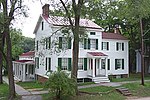Lake–Tysen House

The Lake–Tysen House is a spacious farmhouse with Dutch and Flemish architectural details. It was built by Joseph Guyon on his farmstead in Oakwood, Staten Island in the United States. Most of its original interior woodwork, including both Georgian and Federal styles of paneling remains intact. Based on the style and proportions of the house, it would be considered a middle-to-upper-class dwelling. The Lake family owned several slaves, who may have been housed in the rooms above the kitchen. The building was acquired by Historic Richmond Town, a living history museum, in 1962, and transported from Oakwood during July 9–12, 1962. The building was restored before it was opened to the public on October, 1963. Full restoration was completed in the 1970s.
Excerpt from the Wikipedia article Lake–Tysen House (License: CC BY-SA 3.0, Authors, Images).Lake–Tysen House
Richmond Road, New York Staten Island
Geographical coordinates (GPS) Address Nearby Places Show on map
Geographical coordinates (GPS)
| Latitude | Longitude |
|---|---|
| N 40.572055555556 ° | E -74.145416666667 ° |
Address
Guyon-Lake-Tysen House
Richmond Road
10306 New York, Staten Island
New York, United States
Open on Google Maps








